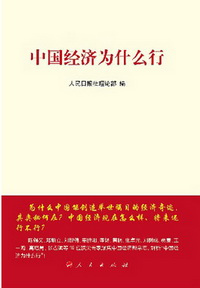Behind the Boom: China's Economic Miracle
2015-09-10
 |
| Behind the Boom: China's Economic Miracle |
This book incorporated the in-depth analysis made by scores of experts and scholars, focusing on China's economic development from diverse perspectives. Based on their respective research fields, the academics gave authoritative explanations on China's economic performance as well as a holistic and systematic picture on China's economic miraculous development. It is hoped that this book could assist the readers to get a more scientific and complete understanding on China's economic boom and its future performance.
In the past 35 years from 1978 to 2013, China witnessed an extraordinary economic development. If measured by the average life expectancy of Chinese people at the beginning of 1980s, 35 years are equivalent to half of a man's life span. During these years, China achieved an annual GDP average growth of 9.8% with a seventeen-fold rise of GDP per capita in real terms, the extent of which exceeds that of any generation in any country in its fastest growing period. Take developed countries as an example, the fastest growing years in their history saw the improvement of an individual's life quality for a lifetime to be, on average, mere 56 percent in Britain, about 100 percent in the United States and 10 times in Japan. American economist Lawrence Summers once commented that historians will not forget to write much about the economic miracle in China even after 300 years.
Academics from both home and abroad all made efforts to probe the mystery of China's miraculous growth and tried to explain it with various reasons. To put it in a broader way, it is the inclusive development brought about by reform and opening-up that spawned China's economic miracle. It is true that there's still a rather huge gap between urban and rural residents in terms of income level and access to basic public services, and according to World Bank standards, there are around 200 million poverty population in China, which means we can't say that all members of the society could benefit equally from economic growth. But generally speaking, China's achievement in economic growth is indeed the outcome of inclusive development.
For China, a large population is the most basic national condition and rich human resources are its major advantage. China's reform began with the household contract responsibility system, targeting the emancipation of productive forces, the enhancement of labor initiatives and efficient resource allocation. From the guideline of “taking crop planting as the major task” to an all-round development in farming, forestry, animal husbandry, side-line production and fishery, from the policy of “leaving the land but not the villages” to migrant farmers working and doing businesses in cities, from migrant labor boom to migrant labor shortage, people's involvement in the reform and opening-up has enabled the economy and income level to grow at an unprecedented speed. In terms of quantitative analysis non-agricultural employment rose from 29% in 1978 to 78% in 2013. Over the past 35 years, 84% of China's economic growth can be attributed to the improvement of such involvement or increment of inclusive development, including the increase of labor forces, the accumulation of human capital, the reallocation of resources relating to the moving of labor forces from agricultural to non-agricultural sectors, a rise in saving ratio incurred from declining population dependency ratio and the slowdown of digressive capital return due to rich labor resources.
Since the launch of the 12th Five-Year Plan, China's demographic dividend is dwindling and its economic growth is turning from a high-speed mode into the new normal state featured by medium-high growing speed. If China wants to keep a sustainable and smooth economic growth, it has to acquire new dividend through reform. In the broad sense, China's inclusive development is still revealing. For example, in order to give a full play to the drive fueled by reform on economic system, we should address issues that are closely relevant to the people when choosing key areas in the reform to make a breakthrough, and remove barricades that hinder the vitality of market entities and the efficiency of market factor allocation. To conclude, more employment opportunities, a more equal supply of basic public services and an income growth that is shared by more people are both the aspirations of the people and the key tasks of reform.
About the author
Lai Youwei was born in March 1975 in Linqu county, Shandong province. From July 1992-July 2003, he studied at Peking University. He got Bachelor's Degree in international economics from School of Economics of Peking University in 1997. He got respectively Master's Degree in world economics in 2000 and PhD in economics from School of Economics in July 2003. Between 1992-1998, he received military training in the Army Institute of Shijiazhuang (from Sep. 1992-July 1993) and worked as a civil servant at a grassroots community (from Aug. 1997-Aug. 1998).
He joined DRC in 2003. From Aug. 2003-April 2006, he served respectively as assistant research fellow, associate research fellow and Deputy Director of Research Office at Research Department of Industrial Economy, DRC. From May 2006-November 2013, he took the posts respectively as Deputy Director and Director at General Office of DRC. He became a research fellow in Jun 2011. From December 2013-present, he is Deputy Director-General of General Office, DRC.














